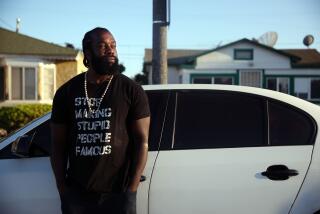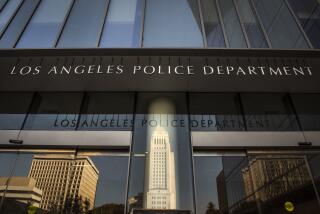Are Officers Who Forgo Turn Signals Above the Law?
- Share via
Dear Street Smart: Why don’t police officers on routine patrol use their turn signals to indicate turns and lane changes? I’m not talking about when they are chasing someone--just cruising the neighborhoods and freeways. We ordinary mortals are expected to use ours.
Mary Sampson Yorba Linda Obviously, a lot of police officers do use their turn signals. But a fair number are just like the rest of us, and get out of the habit. And it’s more than a tad irritating to see someone flout the law when they’re supposed to be enforcing it.
My own pet peeve with the police in my Santa Ana neighborhood is speed. I live in one of those old sections on the north side of town with roads as straight as a slide rule. Lots of people, including many neighbors, thumb their noses at the 25 m.p.h. speed limit.
Those of us who are bothered by these scofflaws occasionally call the police to complain. But the only time I see a police car is when it’s zipping along at about 40 m.p.h. with no lights flashing.
But I’ve got a plan, and I think it could work for your gripes about police officers who haven’t touched their turn signal in months. Next time you see one of these officers of the law driving as if he or she is above it, take down the license number.
Write a carefully crafted letter and send it to the police chief. I find letters get more response than phone calls. For good measure, send it to the mayor.
Sure, they may stick it on some bulletin board and laugh at that lady in Yorba Linda or that knucklehead in Santa Ana. But, then again, maybe someone will take it seriously. Maybe they’ll make an announcement at roll call about improving driving or take an officer out to the car for a reintroduction to the turn signal.
Dear Street Smart:
I am increasingly worried with left-turn etiquette on our roads. Most worrisome are the double left-turn pockets. People are developing the habit of crossing from one lane to the other in the midst of making the left turn.
Additionally, I’ve seen lots of people start making a left turn into parking lots or small streets before opposite flowing traffic has completely passed by. On numerous occasions I have had to speed up, because a car began to make a left turn and underestimated my speed.
What can be done to reduce these tendencies? Would painting stripes on the pavement to indicate where each respective vehicle should be aid in eliminating these problems? How about a method to address the premature left-turn makers?
David Alpern Fullerton It sounds like what you’re describing is bad driving. Curbing such behavior is about as easy as curing the common cold. Perhaps state requirements for more frequent driving refresher courses would help, but don’t hold your breath.
Traffic planners could take some steps, however, to help drivers stay in their turn lanes a bit better. The principal problem I see is with the lane markings.
Many cities no longer paint the lines, relying instead on white reflector dots glued to the pavement to delineate where cars should turn. Sometimes, however, these dots are ripped off by the wear and tear of traffic, and cities don’t replace them. In other cases, enough dots to do the job are never laid down.
The result is that motorists don’t have a ready path to follow, and they occasionally wander out of the proper position. Maybe when some of the money from Measure M and Proposition 111, the local and state transportation-funding measures, begins to trickle down to the cities we’ll see some more maintenance on such sections of roadway.
Dear Street Smart:
As a strict disciple of Smith’s rules of defensive driving, I was horrified to see a current TV ad that touts the well-engineered capabilities of a European motor vehicle by showing it passing a truck on a winding, two-lane mountain road in what appears to be inclement weather. (It’s Mercedes-Benz, if you want the culprit.)
The same company allows its competition access to the technology it has developed studying damage control. The same sort of effort could have been directive via its TV commercial to the prevention of crazy driving one sees on Orange County freeways.
Walter Kadlec Irvine I haven’t been able to find any studies dealing with the effects of TV commercials on road performance, but there is little doubt that such commercials--along with the myriad car chases in movies and television--do have some effect.
I suspect the only way these car companies are going to change is if pressure is put on them, either through letters to newspapers (as you have written) or letters sent directly to the company (sorry if I’m sounding like a broken record.)
Several car companies make a practice of avoiding such guts-and-glory commercials, perhaps because they realize the effects these ads have on motorists, in particular those in their teens. Maybe if enough people get down on the remaining culprits they’ll decide they can sell cars in a more sedate fashion.
Street Smart appears Mondays in the Orange County section of The Times. Readers are invited to submit comments and questions about traffic, commuting and what makes it difficult to get around in Orange County. Letters will be published in upcoming columns. No anonymous letters will be accepted. Please write to Eric Bailey, c/o Street Smart, The Times Orange County, P.O. Box 2008, Costa Mesa, Calif. 92626. Include your full name, address and day and evening phone numbers.
More to Read
Sign up for Essential California
The most important California stories and recommendations in your inbox every morning.
You may occasionally receive promotional content from the Los Angeles Times.










